Since the beginning of this series, I’ve said that the key to making beautiful urban environments is a focus on what I’ve called “Really Narrow Streets.” I think that term has gotten a little old, so I’ve instead adopted the term “Narrow Streets for People.” These Narrow Streets for People are combined with Arterial and Grand Boulevard-size streets, and in modern times trains and subway systems, to create what I’ve called the Traditional City. I’ve said that perhaps 80% of total street length can consist of Narrow Streets for People, with perhaps 20% Arterials and larger, to create an environment that is overwhelmingly people-friendly while also being easy to get around in with motorized wheeled vehicles. Although most streets are Narrow Streets for People, most everywhere is within a quarter-mile or so of an Arterial.
Click Here for the Traditional City/Heroic Materialism Archive
March 26, 2006: The Eco-Metropolis
Mostly I’ve relied on lots of pictures to express some of the details of this. We have a long tradition of making these kinds of places in every culture. And, this is about making real places, not just theorizing to advance our academic careers. Unfortunately, especially in the US, we also now have a long tradition of making absolute crap and then dressing it up in a lot of flowery language. This is OK perhaps as a way to sell the client on an architectural design, but after the thing is built you only get the thing itself and no linguisitic poofery, so whatever you actually built had better not suck. But, perhaps now we have our feet sufficiently on the ground that I can actually begin to talk about some of the more detailed aspects of making these kinds of places in the real world.
Let’s see what this looks like:
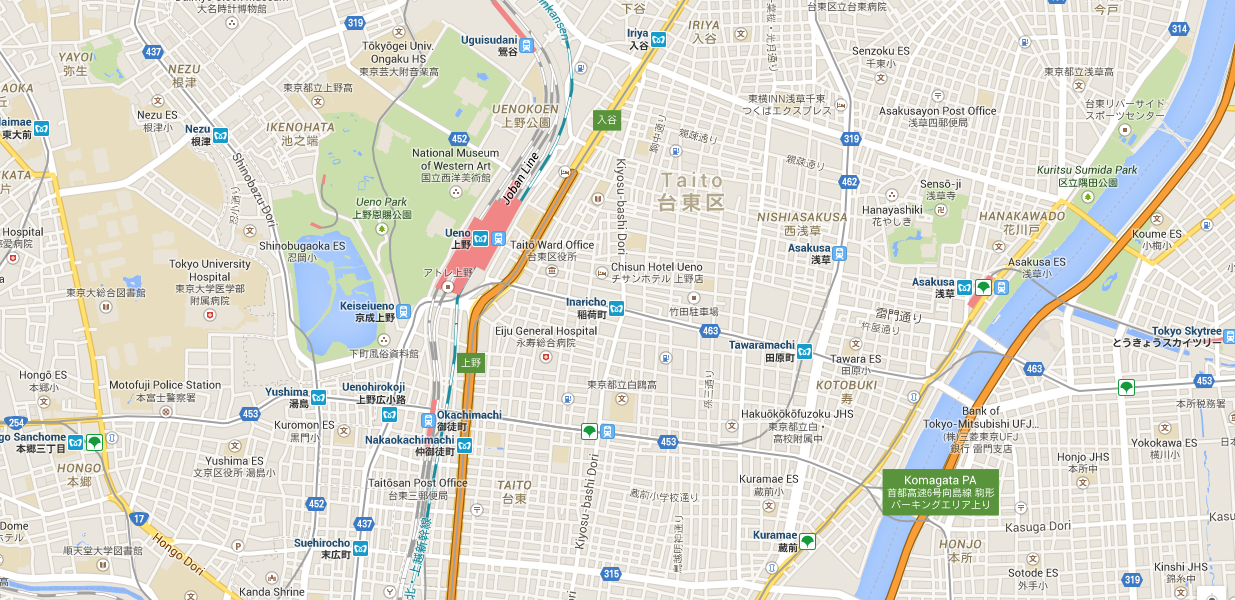
This is a section of Tokyo near Ueno station, which is one of the largest train stations in Tokyo and part of the central city area. We can see some Grand Boulevard-size streets, subways, parks and so forth.

This is a section toward the lower central part of the first map, showing part of Taito-Ku just south of Shin-Okachimachi subway station and Showa Dori, a Grand Boulevard, to the west. You can see a combination of Narrow Streets for People, and also larger Arterials (such as Kiyosubashi Dori) which can be identified by the presence of traffic lights.

Now we are zooming in closer, near the Kojima label. We can see a large Arterial, Kiyosu-bashi Dori. We can see that, although most of the streets (by length) are Narrow Streets for People, Arterials are nearby everywhere. Note the intersection next to the “A” at the end of “Kojima”.

Now we have zoomed in a bit more, near the Kojima label. Note the Narrow Streets for People, and also the Arterials nearby. Note again the intersection just right of the Kojima label.

This is the street view looking east from the intersection near the Kojima label. Of course it is a Narrow Street for People. No sidewalks or roadway segregation. Note that there is no vehicle traffic here, although you can certainly drive here if you want to. (The words painted on the street say “stop” for drivers.) These look like townhouses. They get deliveries, trash pickup etc. from trucks, and some people probably have personal automobiles too, but it is nevertheless a quiet and pleasant place. Note how the doors open right onto the street, with no setback at all. Apparently people feel comfortable enough with this street that they feel no need for a “buffer,” even though vehicle traffic is not banned.

This is the view looking south from the same intersection. This is a little larger Narrow Street for People. We have a few motor vehicles here, but they move slowly and can easily commingle with people on foot or the several people riding bicycles here. Note how people are walking and riding bikes right down the middle of the street. One way you can tell that a street is perceived as being “for People” is that people feel comfortable walking down the middle, even if there are some motor vehicles. This is wider but again we do not have a sidewalk/central roadway segregation. These are mostly houses but there are some small shops and businesses too.
This neighborhood is nothing special, and not particularly attractive compared to some of the marvelous accomplishments in Europe, or elsewhere in Japan. You could do a lot better. The architecture is rather drab and utilitarian. The street surface itself is simple asphalt pavement. This is very cheap and easy to do. But, we can see that, nevertheless, we have created a Pleasant Place for People. Note that this is very much in central Tokyo, an easy walk from the subway and Ueno Station, a very large train station with high-speed rail access to all of Japan. Tokyo University, the most prestigious university in Japan, is an easy walk to the west. The Emperor’s Palace, the absolute center of Tokyo, is perhaps a 30 minute walk away. Otemachi and Marunouchi, the financial district, is about a 25 minute walk.
We have also seen that we are just a few hundred meters away from some very large Arterials and Grand Boulevards, which themselves provide quick access to elevated expressways nearby. And if you did have to drive on a Narrow Street for People, as some people are in the photo above, we can see that is pretty easy too, because there is no traffic.
April 13, 2014: Arterial Streets and Grand Boulevards
Showa Dori, a Grand Boulevard-size street that also has an elevated expressway, is represented in the maps above by a yellow and orange color. It looks like this:

So, we can see that there is no problem getting around in motor vehicles either. Yet, perhaps 80% of streets in this area, and much of Tokyo, are of the Narrow Streets for People format, which have hardly any vehicle traffic at all.
Of course, you could make things a little nicer, with more ambitious architecture.

But, whether you have nice buildings and brick pavement, like this street in Celle, Germany, or simple and cheap buildings with plain asphalt, the basic design is the same. The basic result is the same, too: a Pleasant Place for People.
That’s really all there is to it.
However, let’s talk about a few details.
Since these streets are Narrow Streets for People, how wide are they? The term “Narrow” is really in comparison to the extremely wide streets characteristic of 19th Century Hypertrophism. As Streets for People, they are in a range from a very wide Narrow Street for People, to of course a very narrow Narrow Street for People. For example:

This street in Las Vegas is, for a street for people walking, very very wide. It is probably about 70 or 80 feet from building-to-building. This can be OK if there are a lot of people there, literally thousands as is the case here. It almost functions as a sort of long, narrow public square, rather than a “street.” We also have a long tradition of public squares, a common element in the Traditional City.
Here is another very, very wide street in Beijing:

Again, we are looking at perhaps 100 feet from building to building. So, it is not the street width alone that creates the effect we are looking for. However, in the Beijing example, we can also see that even with thousands of people, the area feels uncrowded and even a little empty. Both the Las Vegas and Beijing examples are probably Arterial conversions, where an existing Arterial street was modified to remove the central vehicle roadway. Note that the street is one flat plane from one side to the other, as if it was all “one sidewalk,” with no curbs and central roadway.
On the other end of the scale, of course we have very narrow Narrow Streets for People, such as this street in Tokyo:

Yes, this is a “street,” not just a gap between buildings. You could make a street even narrower than this. Some named streets are under two feet wide.
Here’s a residential street in Sicily, Italy.

Of course, there are examples in the middle ranges as well:

Santorini, Greece. This varies between about 8 and 12 feet I’d guess.

Shanghai, China. This looks like about 18 feet wide.

Ximending’s Cinema Street 西門 武昌街
Taipei, Taiwan. Although this looks a lot like the very large Las Vegas and Beijing examples, actually the street width is about 40 feet here, which is only about half as much. Even 40 feet building to building makes a very “large” street by walking standards, and can accommodate a large number of people.
In general, most Narrow Streets for People, in cities worldwide, tend to fall between about eight and twenty feet wide. Narrower than this, and vehicle access becomes impossible, which is perhaps not such a bad thing from time to time but you don’t want to have every street like that. Wider than about 20 feet, and a street begins to feel quite barren and empty unless you have literally thousands of people to fill it up, like some of these major shopping destinations. Obviously, not every street can be a major shopping destination with thousands of visitors. Realistically, even a large city like Beijing can support only a few streets like this.

Here we have a people-only area with no roadway for cars, and no cars in any case. And, there are actually a couple dozen people here. But. the area is so large that it feels quite barren. Compare this to a much cozier (=narrower) example, such as this:

Schnoor, Bremen, Germany. The width here is maybe ten feet. I should mention too that you don’t need to have very wide streets even if you do have thousands of people. You can just have dozens and dozens of small streets like this one in Germany. For example, the Shinjuku district in Tokyo is a major destination for millions of people, and surrounds the busiest train station in the world. However, most of the streets are in the 12-25 foot wide range, such as these:


So, I would say that the Narrow Streets for People, which should form perhaps 80% (this is a rough number) of streets in a properly designed Traditional City, tend to be 8-25 feet wide, with some examples of as narrow as three feet and as wide as 40 or 50 feet. There is really no reason to go wider than that.
However, it is not just about width alone. We discussed earlier that the defining characteristic of an Arterial Street is not necessarily the wider width (to accommodate vehicular traffic), but also roadway segregation. An Arterial has — and should have — a central roadway exclusively for vehicle use, and probably has sidewalks that are exclusively for walking. Also, there should probably be a buffer between the two, of a steel rail at the very minimum and perhaps better yet, 3-10 feet of trees or shrubbery. Now, it should be obvious that once you intentionally define the center and largest part of the street for exclusive vehicle use then it is no longer For People.
The characteristic element of what I call the 19th Century Hypertrophic City is that all the streets are Arterial in form. Not only are they very wide, but they also have a central segregated roadway dominated by automobiles. Other than that, the 19th Century Hypertrophic City has many worthy characteristics, notably the dense format without wasted space on parking lots and Green Space, and often rather nice architecture. Also, the better Arterials of the 19th Century Hypertrophic City are often not much different than the Arterials of a Traditional City. This leads many people, especially in the United States, to confuse the 19th Century Hypertrophic City with the Traditional City. But look at the photos of the streets in Shinjuku above. Can you find a street like this in New York? Philadelphia? Minneapolis? Nope. Those cities have only streets that are Arterial in format, and these Shinjuku streets are Narrow Streets for People.
But, that street in Schnoor, Germany is very similar.
February 21, 2010: Toledo, Spain or Toledo, Ohio?
January 31, 2010: Let’s Take a Trip to New York 2: The Bad and the Ugly
January 24, 2010: Let’s Take a Trip to New York City
I think these pictures give an idea of the difference:

This is West 19th Street, Manhattan. The Chelsea district. This is a very, very expensive place to live, one of the most expensive neighborhoods in New York City and indeed the United States.
Of course this is a residential street, not a major thoroughfare. There isn’t even much traffic, although a lot of parked cars. But, look how wide the street is! It is about 80 feet between property lines, with two lanes for cars in the middle, onstreet parking on both sides, a green buffer on both sides, and then sidewalks on both sides. Plus, the buildings themselves have additional setbacks of 6-10 feet or so, on both sides. So, we are approaching 100 feet building to building. Second, because most of this width is consumed by the central roadway, it is thus not a Place for People, but intentionally defined as a Place for Automobiles. And, this is right in front of people’s homes. So, there is no actual place For People in this city outside of the buildings themselves (which generally don’t have any rear gardens or central courtyards), unless you walk to a park somewhere. The entirety of the city is a Place for Automobiles. Look how tiny and forlorn the woman in yellow seems in the middle of all that blank asphalt and stored machinery. Everything is telling her that “you are in a place you don’t belong,” which is true: she is walking in the middle of an automobile roadway. Which is sort of like walking down the middle of some train tracks. You wouldn’t let your three-year old walk in the middle of this street.

Here we have another woman in yellow. This is a Narrow Street for People, somewhere in Indonesia. This is not one of the most expensive neighborhoods in the world. Even by Indonesian standards, I would call this a low-income neighborhood. Basically, it is a slum, and is even rather dirty I would say. The architecture is crude concrete and tin roofs. Aside from the woman herself, it is difficult to identify anything appealing in this picture.
And yet, despite all of these negatives, we sense that this is somehow a Pleasant Place for People. It seems cozy and comfortable in a way that the Manhattan example does not, even though the people in Chelsea have incomes that are probably 100x higher.
Of course, you don’t have to be so crude as this Indonesian slum. You could live in a place like this:

This is the town of Noto in Sicily, Italy. This is what the Chelsea, Manhattan residential street should look like. The width here is about 25 feet from side to side, and we have apartments with a little bit of commercial activity on street level. Italy has been a relatively unprosperous place for decades, and has generally much lower incomes than people in Manhattan (especially in southern Italy), and yet they live in places like this.
Although Arterials tend to be much wider than Narrow Streets for People, as they must accommodate at least two lanes for vehicles in the middle plus sidewalks and buffers on both sides, it is not the width alone that matters. A major element of the Arterial is the roadway segregation into a central roadway for wheeled vehicles and sidewalks on the side. This is the defining characteristic of the Arterial.

This is a street in Paris. Apartments on the side. This is not very wide, perhaps about 20 feet, but obviously it has been segregated in the Arterial format — and even includes some machinery storage! So, people living here go outside and find: a roadway for cars, machinery storage, and a little strip of about 3 feet on the side For People. Ugh. I might say this is even worse than the Chelsea, Manhattan example. At least it makes much more efficient use of space.
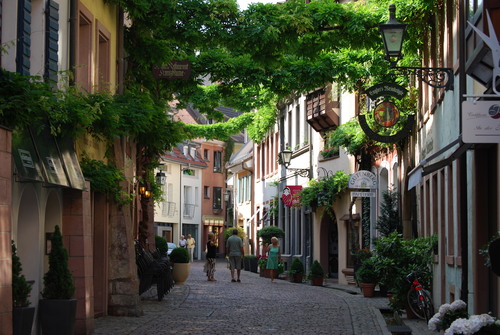
Here we have a street of similar width, about 16 feet, but of course in the Narrow Streets for People format of one flat unsegregated plane. You could drive a motor vehicle here, and it is probably done from time to time for deliveries and so forth, but clearly this is a Place For People, not automobiles. These are again mostly apartments. Don’t you think it would be a much nicer place to live? Freiburg, Germany.

This is another of my favorite examples of a much nicer sort of residential street. You can still have a big Arterial maybe 300 meters away. No problem. But, this is where you actually live.
Don’t you think that is nice? This looks like about 20 feet wide, although it seems narrower because some of the street is being used for outdoor restaurant seating.
On the other end of the scale of Things Not To Do, we find streets from which cars have actually been completely banned — real no-car, walking-only places — but which retain the Arterial format! This is common with “car free days” in various cities. You can get rid of the cars, but the street is still designed for cars. So, you are really just trespassing on an automobile roadway, on a designated Sunday. This does not create Pleasant Places for People.
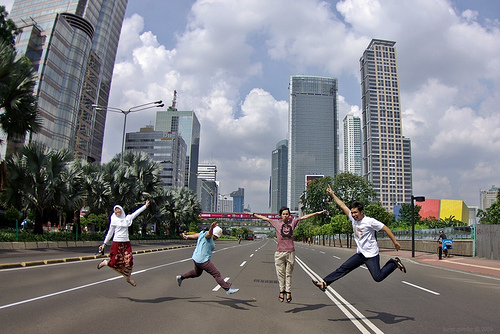
Whoop de do. I’m not saying don’t do it, but this is not really a solution. It is a way of making a bad situation just slightly less-bad.

Grand Boulevards full of automobile traffic are fine. That’s what Grand Boulevards and large Arterials are for. But, you need Pleasant Places for People too. Trying to turn a Grand Boulevard into a temporary park has very limited potential. The reason people do it is because they have no other Place for People to go. But when 80% of your city consists of Narrow Streets for People, then why bother messing with the Grand Boulevard?
In actual practice, however, automobiles are so unpleasant that even in Tokyo, which really is 80%+ Narrow Streets for People with negligible auto traffic, people still feel an advantage from shutting down the big Arterials from time to time. Tokyo is famous for its “pedestrian paradises” on weekends, which alas are not so common now as they once were.
October 10, 2009: Place and Non-Place
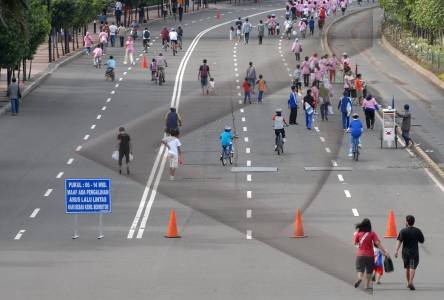
So, it is very important that a Narrow Street for People doesn’t have Arterial roadway segregation. That’s what makes it “for People.” Look again at the photo from Freiburg, Germany. Certainly you can tell the difference?
Now, we are getting to a somewhat more subtle point. Especially in those places where vehicle access is not banned, and where we do get occasional vehicles for pickups and deliveries and so forth — which is the normal state of affairs, because it really is much easier to do trash collection or package delivery with a truck — then we tend to find that people want a hint of roadway segregation. They want to say “keep the vehicles in the middle please, and leave a little bit of room on the sides, like a sidewalk.” But, we also want to avoid more definite forms of segregation, implying an Arterial format.
Arterial segregation is mostly accomplished using curbs. The curbs serve a number of functions. First, they are obviously no fun to drive over, so they physically keep wheeled vehicles in the central roadway defined for their use. Second, they are useful for drainage. We also tend to see them used as property line definitions, between a private plot of land and the public roadway. Obviously, here the curb does not separate a sidewalk, because a sidewalk is part of the public road. However, the curb that serves as a property line boundary can also serve as the defining line of a small setback between the building and the roadway, which is a little bit like a sidewalk. Lastly, the curb serves as a visual indicator of the intended organization of the road space. Whatever its functional use, it also sends a message that “this area is for people and this area is for cars.”
So, we want something that sends a message that “drivers need to behave themselves” but also sends a message that “this is a Street for People, not cars.” A common Japanese solution is to use a paint stripe, which is something like a shoulder. A variant of this is a roadway surface that is a different color, such as red. This is not a curb, it is just a paint stripe. It has no functional use, for physically separating the street or for drainage, but is wholly informational. There is no “sidewalk,” just a vaguely-defined area like a shoulder. But, it does imply that drivers should take it easy because this is a Place for People, and also not get too close to the sides. It also helps keep the central roadway clear, as people seem to perceive that they shouldn’t park their bikes and motorcycles “over the line.”

This is particularly true when the street is a little wider, such that there is enough space that vehicles might drive a little faster. On narrower streets, there seems to be less perceived need for this sort of marking.

Note that is is a neighborhood of single-family detached residences, or what you could call a “suburb.” The Traditional City pattern of Narrow Streets for People is completely compatible with these lower-density formats, as we looked at extensively in the past.
July 31, 2011: How To Make a Pile of Dough With the Traditional City 5: The New New Suburbanism
July 17, 2011: How To Make A Pile of Dough With the Traditional City 4: More SFDR/SFAR Solutions
June 12, 2011: How to Make a Pile of Dough with the Traditional City 3: Single Family Detached in the Traditional City Style
This has been true not only in Japan, but elsewhere such as this neighborhood in Germany.

Or, this one in Houston, Texas!


Here we see the paint stripe “shoulders”, and also the use of the red surface. Makes sense since this is apparently a bus route! Note how people walking, storefronts, and even a very large vehicle like a bus can get along together. Tokyo.

Paint stripes used in a residential neighborhood, Tokyo. Note, in addition to the garbage truck, that we also have bikes and personal automobiles here.

Paint stripes used here, with a truck making a delivery or pickup.

Paint stripes used in an SFDR neighborhood. Seijo, Tokyo.
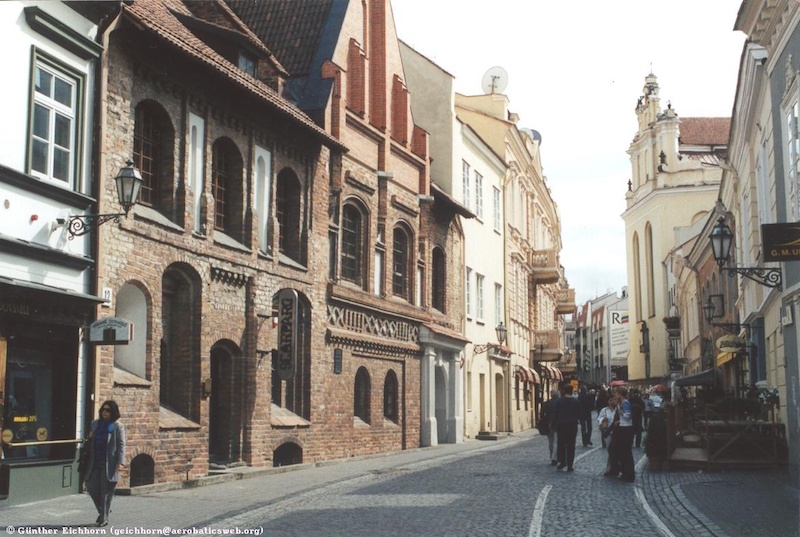
Here we have a (slightly) different color roadway surface on the left, and a paint stripe on the right. Vilnius, Lithuania.
I think that is all for today. We will continue this discussion about some of the details of making Narrow Streets for People, including typical modes of success and failure.

